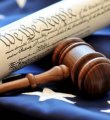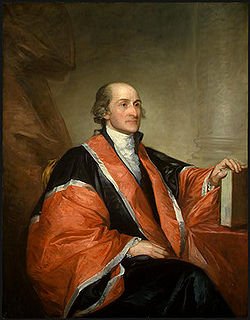

FIRST CHIEF JUSTICE
OF THE UNITED STATES SUPREME COURT
It is thought the way the clause "natural born citizen" got into the United States Constitution is through a letter of July 25, 1787, from John Jay (who was born in New York) to George Washington (who was born in Virginia), presiding officer of the Constitutional Convention.
John Jay wrote to George Washington:
"Permit me to hint, whether it would be wise and seasonable to provide a strong check to the admission of Foreigners into the administration of our national Government; and to declare expressly that the Commander in Chief of the American army shall not be given to nor devolve on, any but a natural born Citizen."
Source:
The Life John Jay With Selections from His Correspondence and Miscellaneous Papers. by His Son, William Jay in Two Volumes. Vol. II., 1833.
There was no debate, and this qualification for the office of the Presidency was introduced by the drafting Committee of Eleven, and then adopted without discussion by the Constitutional Convention.
The phrase "natural born citizen" was subsequently defined in the Constitution and in the decisions of the U.S. Supreme Court as:
A NATURAL BORN CITIZEN IS A PERSON WHO WAS BORN IN THE UNITED STATES OF AMERICA OF TWO PARENTS, BOTH OF WHOM WERE AMERICAN CITIZENS AT THE TIME OF THE BIRTH OF THE CHILD.
John Jay grew up in New York City and became a lawyer. His ability to compromise and negotiate with others led him to help draft the constitution for the State of New York. Like many of America's founding fathers, John dreamed of a fair government system. When tension grew between Great Britain and the American colonists, he first opposed war, but later drafted a compromise document called, Address to the People of Great Britain.
During the Revolutionary War, John sent cannons to George Washington's troops in New York. He also organized a council to search for spies and traitors. He later traveled to Paris and worked with Benjamin Franklin to negotiate peace with Great Britain. His cooperative skills resulted in the Treaty of Paris, which officially concluded the Revolutionary War.
After the war, John grew frustrated with the weakness of the new government established by the Articles of Confederation. He wrote five essays with Alexander Hamilton and James Madison to argue for a new government structure. Their writings, called the Federalist Papers, led to the state of New York joining the Union and ratifying the U.S. Constitution.
John's work caught the attention of President George Washington, who named him the first Chief Justice of the U.S. Supreme Court. John created many of the procedures used by the Supreme Court. President Washington later sent John to Great Britain to help avoid another war. The agreement, called the Jay Treaty, settled the dispute and promoted commercial prosperity. At the time, the treaty was a national controversy, and John lost an opportunity to be considered for the Presidency. He later became Governor of New York. John's cooperation and abilities left a lasting legacy on the formation of the government of the United States.
We, as a Nation, are deeply indebted to him!
No comments:
Post a Comment